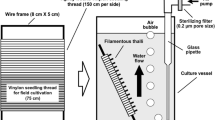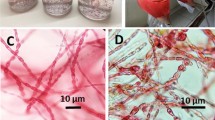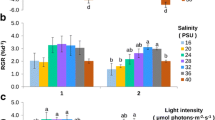Abstract
Grateloupia turuturu Yamada is an economically valuable red alga with great potential in nutraceuticals and pharmaceuticals. Filaments of G. turuturu are of primary importance in germplasm preservation and sporeling culture, although filaments were not present in its life cycle. In this study, effects of temperature (10, 15, 20, 25, and 30 °C) and irradiance (10, 30, 60, and 90 μmol photons m−2 s−1) with photoperiod 10:14 h (light/dark) on filament development were investigated. Our results indicated that 25 °C was the optimal temperature for the formation of discoid crusts regardless of the irradiance. Conditions of 20 °C and 60 μmol photons m−2 s−1 promoted the development of discoid crusts and formation of upright thalli.


Similar content being viewed by others
References
Aguirre-Lipperheide M, Estrada-Rodriguez FJ, Evans LV (1995) Facts, problems and needs in seaweed tissue culture: an appraisal. J Phycol 31:677–688
Barreiro R, Quintela M, Bárbara I, Cremades J (2006) RAPD differentiation of Grateloupia lanceola and the invasive Grateloupia turuturu (Gigartinales, Rhodophyta) in the Iberian Peninsula. Phycologia 45:213–217
Cabioch J, Castric-Fey A, L’Hardy-Halos MT, Rio A (1997) Grateloupia doryphora et Grateloupia filicina var. luxurians (Rhodophyta, Halymeniaceae) sur les côtes de Bretagne (France). Cryptogamie Algol 18:117–137
Chen YC, Chiang YM (1994) Development of protoplasts from Grateloupia sparsa and Grateloupia filicina (Halymeniaceae, Rhodophyta). Bot Mar 37:361–366
Chen YC, Chiang YM (1995) Ultrastructure of cell wall regeneration from isolated protoplasts of Grateloupia sparsa (Halymeniaceae, Rhodophyta). Bot Mar 38:393–399
Dawes CJ, Koch EW (1991) Branch micropropagule and tissue culture of the red algae Eucheuma denticulatum and Kappaphycus alvarezii farmed in the Philippines. J Appl Phycol 3:247–257
D’Archino R, Nelson WA, Zuccarello GC (2007) Invasive marine red alga introduced to New Zealand waters: first record of Grateloupia turuturu (Halymeniaceae, Rhodophyta). NZ J Mar Freshw Res 41:35–42
Denis C, Massé A, Fleurence J, Jaouen P (2009) Concentration and pre-purification with ultrafiltration of a R-phycoerythrin solution extracted from macro-algae Grateloupia turuturu: process definition and up-scaling. Sep Purif Technol 69:37–42
Denis C, Morancais M, Li M, Deniaud E, Gaudin P, Wielgosz-Collin G, Barnathan G, Jaouen P, Fleurence J (2010) Study of the chemical composition of edible red macroalgae Grateloupia turuturu from Brittany (France). Food Chem 119:913–917
Farnham WF (1980) Studies on aliens in the marine flora of southern England. In: Price JH, Irvine DEG, Farnham WF (eds) The shore environment 2: Ecosystems. Academic, London, pp 875–914
Fu CH, Yan XH, Huang LB, Li L (2011a) The releasing and high-temperature resistance of conchospores from an improved strain in Porphyra yezoensis Ueda (Bangiales, Rhodophyta). Oceanol Limnol Sinica 42:460–466 (in Chinese with English abstract)
Fujiwara-Arasaki T, Mino N, Kuroda M (1984) The protein value in human nutrition of edible marine algae in Japan. Hydrobiologia 116/117:513–516
Fu XT, Qin ZH, Xu JC, Gao X, Fang YC (2011b) Analysis and evaluation of nutritional quality of Grateloupia turuturu. Acta Nutrimenta Sinica 33:199–203 (in Chinese)
Gavio B, Fredericq S (2002) Grateloupia turuturu (Halymeniaceae, Rhodophyta) is the correct name of the non-native species in the Atlantic known as Grateloupia doryphora. Eur J Phycol 37:349–359
Harlin MM, Villalard-Bohnsack M (2001) Seasonal dynamics and recruitment strategies of the invasive seaweed Grateloupia doryphora (Halymeniaceae, Rhodophyta) in Narragansett Bay and Rhode Island Sound, Rhode Island, USA. Phycologia 40:468–474
Hellio C, Simon-Colin C, Clare A, Deslandes E (2004) Isethionic acid and floridoside isolated from the red alga, Grateloupia turuturu, inhibit settlement of Balanus amphitrite cyprid larvae. Biofouling 20:139–145
Huang W, Fujita Y, Ninomiya M, Ohno M (1999) Seed production and cultivation of Grateloupia turuturu (Cryptonemiales, Rhodophyta) by callus culture. Bull Marine Sci Fish 19:1–7
Iima M, Kinoshita T, Kawaguchi S, Migita S (1995) Cultivation of Grateloupia acuminata (Halymeniaceae, Rhodophyta) by regeneration from cut fragments of basal crusts and upright thalli. J Appl Phycol 7:583–588
Ishikawa Y (1984) New seaweed resources 2: cultivation of Grateloupia filicina. Suisan no Kenkyu 3:57–60
Jiang CM (2011) Study on the development of carpospores and discoid crusts of Grateloupia turuturu (Halymeniaceae, Rhodophyta). Dissertation, Ocean University of China, Qingdao (in Chinese with English abstract)
Lafontaine N, Mussio I, Rusig AM (2011) Production and regeneration of protoplasts from Grateloupia turuturu Yamada (Rhodophyta). J Appl Phycol 23:17–24
Ma LB, Wang SJ, He PM (1995) Artificial breeding of commercial important red algae: Grateloupia. J Shanghai Fisheries University 4:93–98 (in Chinese with English abstract)
Marston M, Villalard-Bohnsack M (2002) Genetic variability and potential sources of Grateloupia doryphora (Halymeniaceae, Rhodophyta), an invasive species in Rhode Island waters (USA). J Phycol 38:649–658
Miyazawa K, Ito K (1974a) Isolation of L-methionine-l-sulfoxide and N-methylmethionine sulfoide from a red alga Grateloupia turuturu. Bull Jpn Soc Sci Fish 40:655–660 (in Japanese)
Miyazawa K, Ito K (1974b) Isolation of a new peptide, L-citrulliny-L-arginine, from a red alga Grateloupia turuturu. Bull Jpn Soc Sci Fish 40:815–818 (in Japanese)
Pang SJ, Xiao T, Shan TF, Wang ZF, Gao SQ (2006) Evidences of the intertidal red alga Grateloupia turuturu in turning Vibrio parahaemolyticus into non-culturable state in the presence of light. Aquaculture 260:369–374
Plouguerné E, Hellio C, Deslandes E, Véron B, Stiger-Pouvreau V (2008) Anti-microfouling activities in extracts of two invasive algae: Grateloupia turuturu and Sargassum muticum. Bot Mar 51:202–208
Ribera MA, Boudouresque CF (1995) Introduced marine plants, with special reference to macroalgae: mechanisms and impact. Prog Phycol Res 11:187–268
Robaina RR, García-Jiménez P, Luque A (1996) Light and glycerol driven development of Grateloupia doryphora (Rhodophyta) in vitro. Sci Mar 60:283–289
Rodrigo M, Robaina RR (1997) Stress tolerance of photosynthesis in sporelings of the red alga Grateloupia doryphora compared to that of Stage III thalli. Mar Biol 128:689–694
Saunders GW, Withall RD (2006) Collections of the invasive species Grateloupia turuturu (Halymeniales, Rhodophyta) from Tasmania, Australia. Phycologia 45:711–714
Simon C, Ar Gall E, Deslandes E (2001) Expansion of the red alga Grateloupia doryphora along the coasts of Brittany (France). Hydrobiologia 443:23–29
Simon-Colin C, Kervarec N, Pichon R, Deslandes E (2004) Purification and characterization of 4-methanesulfinyl-2-methylamino butyric acid from the red alga Grateloupia doryphora Howe. Phytochemistry Rev 3:367–370
Shao KS, Wang JX, Zhou BC (2004) Production and application of filaments of Grateloupia turuturu (Halymeniaceae, Rhodophyta). J Appl Phycol 16:431–437
Tseng CK (1983) Common seaweeds of China. Science, Beijing
Verlaque M, Brannock PM, Komatsu T, Villalard-Bohnsack M, Marston M (2005) The genus Grateloupia C. Agardh (Halymeniaceae, Rhodophyta) in the Thau Lagoon (France, Mediterranean): a case study of marine plurispecific introductions. Phycologia 44:477–496
Villalard-Bohnsack M, Harlin MM (1997) The appearance of Grateloupia doryphora (Halymeniaceae, Rhodophyta) on the northeast coast of North America. Phycologia 36:324–328
Villalard-Bohnsack M, Harlin MM (2001) Grateloupia doryphora (Halymeniaceae, Rhodophyta) in Rhode Island waters (USA): geographical expansion, morphological variations and associated algae. Phycologia 40:372–380
Wang GG, Jiang CM, Wang SS, Wei XJ, Zhao FJ (2012) Early development of Grateloupia turuturu (Halymeniaceae, Rhodophyta). Chin J Oceanol Limnol 30:264–268
Wang QH, Liu YP, Zhang ED, Li DP, Zhang LC (2005) Cryopreservation of clonal gametophytes of Undaria pinnatifida by encapsulation-dehydration. Acta Oceanol Sinca 27:154–159 (in Chinese)
Xie SP, Song WL, Huang J, Ma P, Yan XH (2006) The sporeling culture of SF-1 of Porphyra haitanensis. J Aquacult 27:39–44 (in Chinese)
Xie CT, Chen CS, Xu Y, Ji DH (2010) Construction of a genetic linkage map for Porphyra haitanensis (Bangiales, Rhodophyta) based on sequence-related amplified polymorphism and simple sequence repeat markers. J Phycol 46:780–787
Xu Y, Xie CT, Chen CS, Ji DH, Gao YH (2010) Construction of a genetic linkage map for Porphyra haitanensis. J Fisheries of China 34:1354–1362 (in Chinese with English abstract)
Yin MY (2005) Studies on tissue culture for seed stock and seedling of marine macroalgae. Dissertation, Institute of Oceanology, Chinese Academy of Sciences (in Chinese with English abstract)
Zhang LJ (2000) Initial study on the isolated regeneration of the fragments of Grateloupia livida (Harv.) Yamada. J Jimei University (Natural Science) 5:35–39, in Chinese with English abstract
Zhang ZY, Wei HX, Han YX, Wang GS (2007) Induction and seedling incubation of filaments from crusts of seaweed Grateloupia filicina. J Dalian Fisheries University 22:164–169 (in Chinese with English abstract)
Acknowledgments
This study was sponsored by the Natural Science Foundation of Shandong Province, China (no. Y2007D42); the Science and Technology Development Project of Qingdao, China, 12-1-4-1-(4)-jch; the Scientific Research Foundation for the Returned Overseas Chinese Scholars, State Education Ministry, (2010) 1561; and the Student Research Training Program of Ocean University of China (no. 201210423048).
Author information
Authors and Affiliations
Corresponding author
Rights and permissions
About this article
Cite this article
Wei, X., Shuai, L., Lu, B. et al. Effects of temperature and irradiance on filament development of Grateloupia turuturu (Halymeniaceae, Rhodophyta). J Appl Phycol 25, 1881–1886 (2013). https://doi.org/10.1007/s10811-013-0018-3
Received:
Revised:
Accepted:
Published:
Issue Date:
DOI: https://doi.org/10.1007/s10811-013-0018-3




